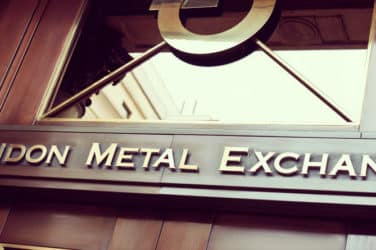
LME issues discussion paper on future market structure
- Proposals to enable the LME to modernise and create a metals market fit for the future, adapting to the needs of its evolving customer base and expectations from wider stakeholders
- LME remains committed to strategic principles laid out in 2017 Strategic Pathway
- Proposals focus on the Ring, liquidity enhancement, margin methodology and market conduct
- Commitment to maintain date structure and protect the flexibility offered through the member-to-client relationship
The London Metal Exchange (LME) today issued a discussion paper on market structure, putting forward a set of proposals designed to enable the Exchange to modernise and adapt to emerging trends and evolving customer needs.
The proposals aim to achieve increased transparency and a structurally fairer and more efficient marketplace. They also take account of the rapidly increasing digitisation across commodity trading and the physical metals industry more broadly.
Today we issued a discussion paper on #LME market structure including proposals designed to enable the LME to modernise and adapt to emerging trends and evolving customer needs. Find out more > https://t.co/jNAhhiuVSV pic.twitter.com/k0ZjUJzWV5
— London Metal Exchange (LME) (@LME_news) January 19, 2021
Matthew Chamberlain, LME Chief Executive, commented: “As we set out in the 2017 Strategic Pathway, it is vital that the LME continues to adapt to serve its diverse trading community as effectively as possible. Three years on, it is clear that a desire for greater transparency and fairness, and increasing digitisation across commodities trading, require us to consider changes to some elements of the LME’s structure.
“The LME has an important role to play in responding to these trends, and we believe it is the right time to consider the future development of our market in order to secure its long-term sustainability and growth and maintain the highest standards in our broader ecosystem.”
The discussion paper considers several changes to the LME, which are focused on four main topics as set out in detail below: the Ring and reference prices; enhancing liquidity in the market; the potential benefits of moving to a realised variation margin methodology; and the possible introduction of additional disclosures and policies to strengthen market conduct.
The discussion paper also identifies key features which the LME wishes to protect and maintain – such as its date structure – and this balance is reflective of the Exchange’s commitment to the principles set out in its 2017 Strategic Pathway: serving the physical market, ensuring fairness, increasing user choice and maximising trading efficiency.
The Ring and reference pricing
The LME believes it is the right time to consider the permanent closure of the Ring and a move to an electronic pricing structure. This shift is expected to benefit the market by broadening direct participation during the price discovery periods and increasing overall transparency.
Mr Chamberlain commented: “The Ring is a greatly treasured aspect of the LME’s rich 144-year history, and its closure is not a decision we or our market will take lightly. However, the LME has stood the test of time precisely because of its ability to adapt to the evolution of market dynamics and trading behaviour.
“For the last 10 months, the Ring had to be temporarily closed due to the global COVID-19 pandemic. We have been clear that we will not use the pandemic as a pretext to close the Ring, and we remain committed to this; however, it is fair to observe that this period of electronic pricing has served the market well, with consistently high volumes of activity in the pricing window, easily observable by all stakeholders, and more participants with direct access.
“Given the data, and our industry’s continued move towards digitisation and greater transparency, we believe it is now time to consider the long-term future of pricing at the LME – with the intention of providing certainty, which will allow all customers to make their future business decisions with confidence.”
Enhancing liquidity
The second set of proposals put forward are designed to bring greater liquidity to the central electronic venue, which is by nature the most transparent marketplace and enables the broadest participation. The proposals specifically focus on incentivising electronic trading on the member-to-member market in the following ways:
- Increasing fees for inter-office member-to-member trades, while reducing fees for electronic member-to-member trades
- Introducing the Enhanced Transparency Cross – which combines the flexibility of the inter-office market with the transparency of the electronic market, by allowing members to bilaterally negotiate trades pre-execution and then to transact or “cross” any proposed trades in the electronic market, at the lower electronic fee
- Potentially introducing block rules and a liquidity provider programme
Adrian Farnham, LME Clear Chief Executive, noted: “Crucially, the LME believes that these steps will further strengthen and protect its unique date structure. By bringing electronic displayed liquidity to a broader range of trading dates, it will be even easier for market users to take advantage of the flexibility of the LME’s daily delivery structure.
“Furthermore, the LME is committed to providing the right balance between maximising transparency and fair access while ensuring that customers – particularly in the physical market – retain their freedom to choose how to do business with their LME member. The LME does not propose to make any changes to its member-to-client trading structure, which benefits physical customers by enabling bespoke and flexible bilateral trade negotiations to take place.”
Margin methodology
The move from a “discounted contingent variation margin” (CVM) methodology to one of “realised variation margin” (RVM) was first considered in the 2017 Strategic Pathway, where the decision was made to keep the potential change under ongoing review. This discussion paper highlights the increased focus on the regulatory capital costs associated with CVM and explores the potential benefits of moving to an RVM methodology, which include an increase in trading efficiency, greater standardisation and the removal of some barriers to entry to the LME’s market. However, the discussion paper also notes the central importance of credit provision in the LME ecosystem, and understands the view of many observers that such provision is easier under the current CVM structure.
Given the finely balanced nature of this debate, the discussion paper invites views on the relative merits of CVM and RVM, so that an appropriate roadmap can be developed.
Market conduct
Finally, the discussion paper considers the introduction of potential additional disclosures and policies to strengthen market conduct, such as in relation to stocks and the movement of physical metal. The discussion paper explores a regulatory news service for stock warranting or cancellations. It also considers some form of disclosure obligation for certain physical transactions, above a specific size, by those trading on the LME. The paper also explores regular reporting of OTC positions or rules to limit any one party’s ability to acquire significant holdings of new or remaining warrants.
Next steps
The LME invites feedback on all topics within the discussion paper from market participants and broader stakeholders from now until 19 March 2021. The LME aims to provide feedback and next steps before the end of the second quarter this year.
Gay Huey Evans OBE, LME Chairman, concluded: “The LME has a strong history of engagement with its market, and is committed to fully discussing these topics with all stakeholders before making any proposals on implementation. We encourage feedback from across our industry on our proposed path forward.”
Source: LME




